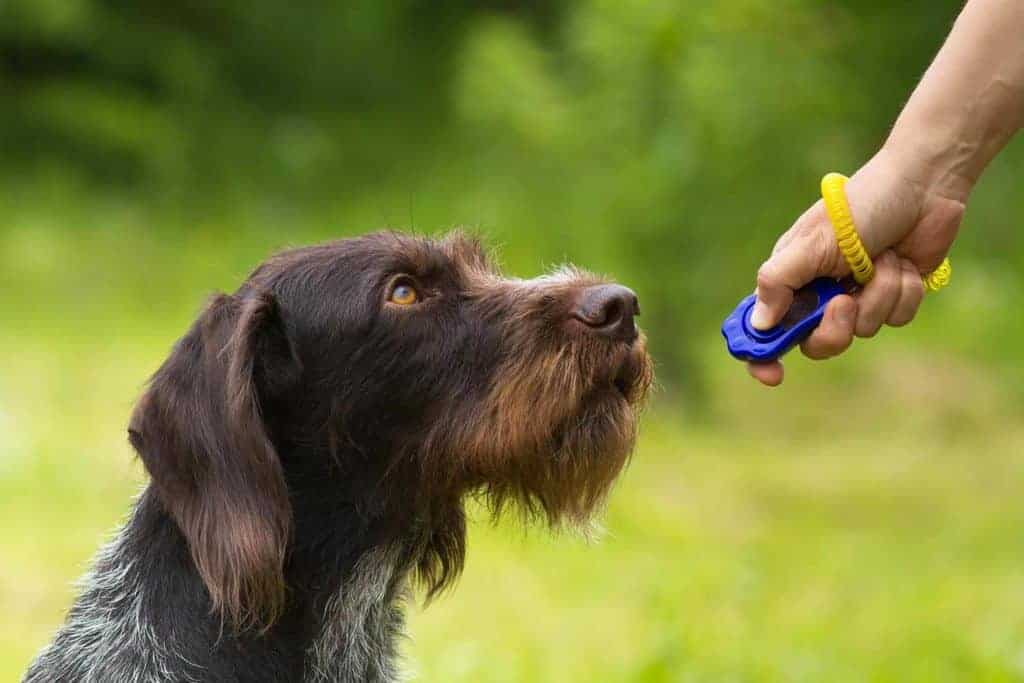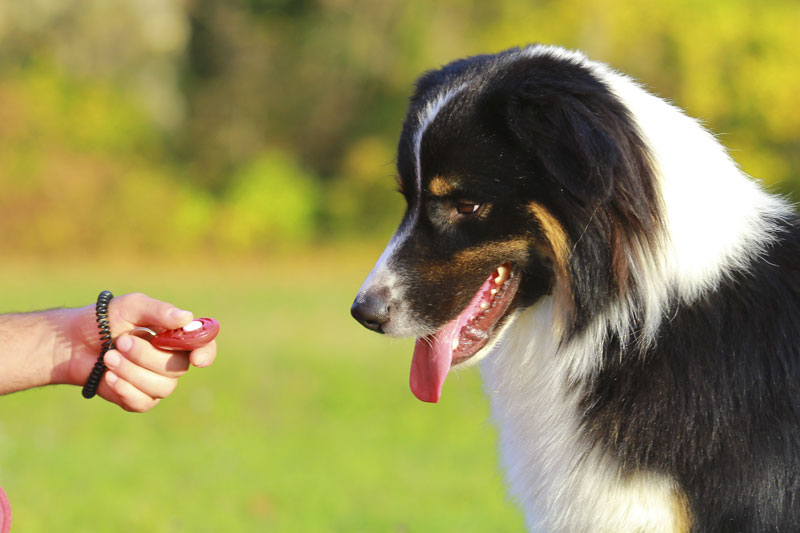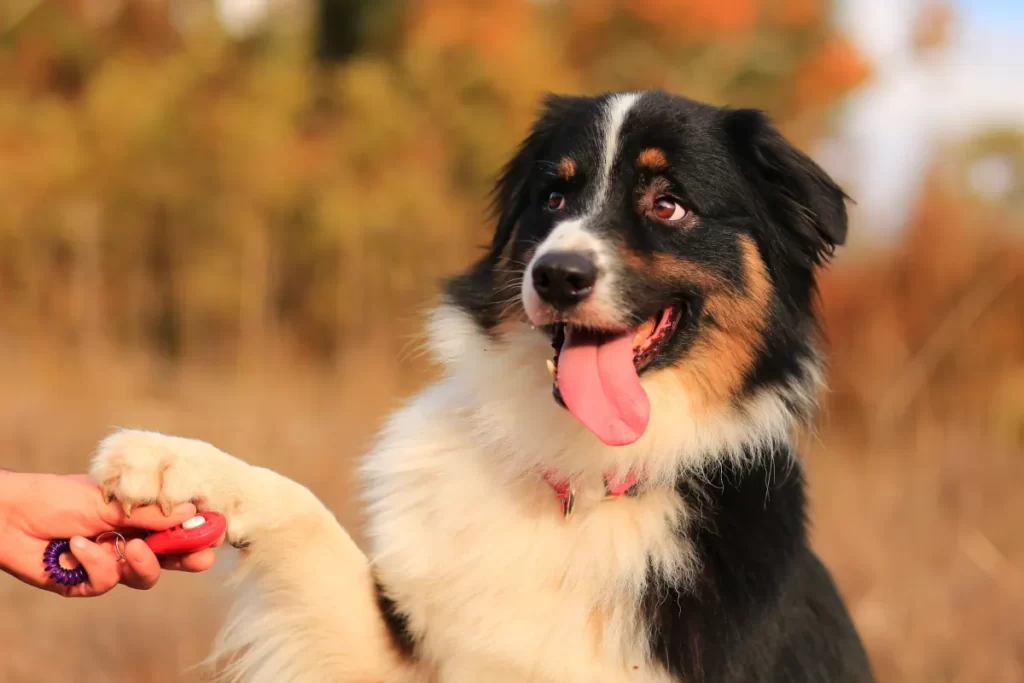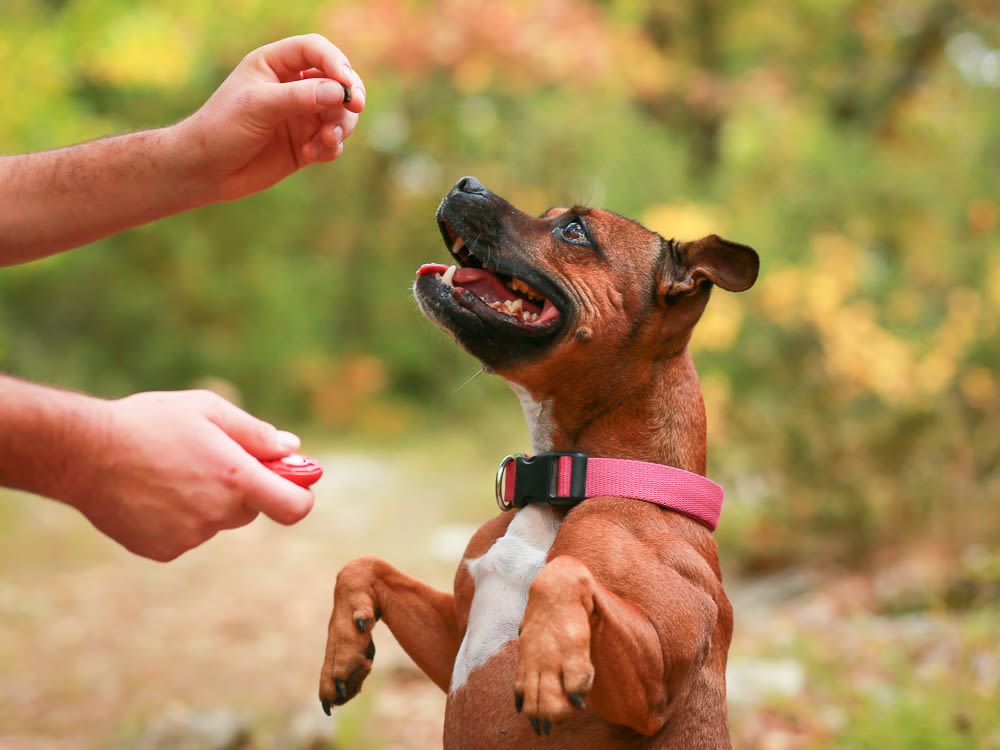Positive reinforcement dog training techniques include clicker training, also known as mark and reward. Your dog will know exactly when you want them to do something thanks to the clicker or marker. Every click must be followed by a reward, and the timing of the click is crucial.
Clickers, which are used in training, can be purchased online or in most pet stores, though you can use any object that makes a brief, recurrent sound (or a particular visual signal for deaf animals) and won’t be used outside of a training context. Some have wrist straps so you can still hold the lead for your dog. Your dog anticipates getting a treat when they hear the clicker!
You can train your puppy using a clicker in the right way by reading this article.
What Is Clicker Training?
The benefits of a clicker make clicker training similar to positive reinforcement training. Simple mechanical noisemaker—that is, a clicker. The methods are based on the theory of animal learning, which holds that behaviors that are rewarded are more likely to be repeated in the future.
As a result, clicker training flips the script and concentrates on what your dog is doing right rather than on what they are doing incorrectly and taking good behavior for granted. You can have a huge impact on how your dog chooses to behave by instructing them on what to do rather than what not to do.
The clicker is useful because it specifically tells your dog which behavior you are rewarding. By clicking at the right time, you can “mark” the moment your dog did what you wanted. As a result, the click informs your dog exactly what they did correctly rather than forcing them to guess what you liked. As an illustration, you would click when your dog’s butt touched the ground if you were teaching it to sit.
You can check out more information we have on leash training, crate training, potty training, and bell training.
What Is The Meaning Of The Click?
The clicker is merely a way to record an event. Except for the fact that you almost certainly never use it around your dog outside of training, that particular noise is not particularly magical. Therefore, anything can be used as a marker as long as it differs from other ways you communicate with your dog.
You could, for instance, whistle, snap your fingers, or cluck your tongue. Many people use a marker word, like “Yes” or “Good.” You could tap the shoulder of a dog who has trouble hearing lightly or gently.
Without a reward, the click or other marker is obviously meaningless. A reward is simply promised when you click. Although most dogs find that edible treats are the best motivator, anything that your dog values can be a reward.
Play tug-of-war with your dog instead of giving her a piece of chicken if she prefers to work for it. Timing and consistency are key components. Every click must come at the right time and be followed by a reward.

Why Use Clicker Training?
When a dog displays the desired behavior, they are rewarded with positive reinforcement training. It might be clear to the trainer what is being rewarded without the use of a clicker or other marker, but is it clear to the dog?
How do you, for instance, make it clear to a dog that you are rewarding its belly for being on the ground when you are teaching it to lie down? Make sure the dog receives the reward while lying down rather than getting up to receive it. Otherwise, the dog might assume that the treat comes for getting up or moving closer to you. With food treats, that is simple, but it is impossible if the reward is a game of fetch or tug.
What about dogs who instantly get out of a down position when they touch the ground? You simply cannot provide them with the reward quickly enough. What about more difficult behaviors, such as those carried out at a distance? How can you train your dog to jump through a hoop at the exact moment it passes through?
The strength of the click or other marker enters into play here. By bridging the time until the reward arrives, the click signals the moment you are going to reward. Your dog is fully aware of the proper course of action.
But why not just use compliments in the same way? You could, but it’s not at all obvious. Praise is a common form of communication with your dog. In fact, it’s a great way to give your dog praise. Not only that, but you wouldn’t want it to be the case since praise isn’t tailored specifically to the context of training. The joy of dog ownership includes gushing over your pet. The use of a clicker or another training-specific marker eliminates any uncertainty regarding the forthcoming reward.
Clear communication is advantageous, but clicker-trained dogs also frequently enjoy learning. To get a click, they want to put in a lot of effort and training. Mark and reward training turns teaching new behaviors into a game from the perspective of your dog. It also relieves the trainer of some pressure.
Instead of dwelling on errors, you should be looking for clickable moments to highlight your dog’s wise decisions. Similar to other positive reinforcement training methods, clicker training improves communication, strengthens your relationship with your dog, and makes training enjoyable.
How To Clicker Train Your Puppy?
Working with an Association of Pet Dog Trainers (APDT) accredited trainer to train your dog is always recommended because they can provide you with a detailed plan on how to raise each individual dog using effective training techniques.
When in doubt, it’s best to stick to the schedule your trainer has given you, but if you decide clicker training is the right choice for you and your dog, read our simple instructions to learn how to get started.
The Golden Rule: With Clicker Training, Timing Is Everything
Make sure to click at the proper time. Try to click right when your dog completes the action you are asking for; otherwise, your dog might become confused.

Step 1 – Learning The Click
Before you can use the click to train your dog, they must understand that it indicates a reward. Take them to a peaceful location with their favorite reward. If it’s food, don’t forget to reduce their daily food intake to prevent weight gain.). Then click the clicker and immediately give them a reward.
You only need to click once, and as soon as possible after that, you should receive your reward. If they’re doing something you want to discourage, try not to click and reward them. For a few days, do this in sessions of two minutes or less several times each day. You want to reach the point where they look at you and anticipate receiving something as soon as you click.
Step 2 – Basic Behaviours
You can begin using it for fundamental training once your dog understands that the click signals a reward. Try beginning by teaching your dog to sit as a simple exercise. You should slowly raise and lower a treat or toy over your dog’s head while holding it in your hand, depending on what motivates your dog. They should immediately recline.
This is called “luring”. As soon as their bum touches the ground, you need to click. They will understand that behavior is what they are being rewarded for in this way. Don’t forget to give them their reward as soon as you can following the click.
Step 3 – Add A Command
Once you’re happy you can “lure” your dog to sit, you can add a command word. Use a reward similar to the one in step 2 to encourage your dog to take a seat after being instructed to do so. Make sure to click and reward once their bum touches the ground. Try again after a few tries to see if they can perform the command without the lure. Never force your dog to do anything; you want them to associate training with positive experiences.
Step 4 – Practice Makes Perfect
Repeat this in quick training sessions (10–15 minutes at most, though young puppies may require even shorter sessions) and your dog will soon learn that the word “sit” denotes that specific action, leading to automatic compliance.
You can begin to lessen the frequency of giving them the treat after the click once they are performing with assurance. By this point, the click should be sufficient compensation, and sometimes prolonging the association by delaying the treatment is preferable.
Top Tips For Successful Dog Clicker Training
- Timing is everything. The behavior that is being rewarded for in your dog must be understood. Try to click during the correct behavior if you can, and give the treat immediately afterward.
- Reward every time. Each click must be followed by a guaranteed treat during the initial phases of training. So even if you mistakenly click the clicker, reward your dog anyhow.
- The treats ought to be small. Many treats are necessary during dog clicker training. To prevent your dog from gaining weight, keep them small.
- The finish on a high note. Although it’s a lot of fun, training does require some effort from both you and your dog. Always conclude the training session with positive action, a click, a treat, and lots of praise.
- Put the clicker in phase. A dog training clicker should only be used to teach new behaviors, keep this in mind. When your dog responds to verbal commands alone, you should gradually stop using the clicker (and the treats).
Pros And Cons Of Clicker Training
Let’s address the most common question that dog owners have concerning clicker training- For clicker training, how old should my dog be?
The good news is that training with a clicker is effective for dogs of all ages and breeds. Even older dogs who have received traditional training are adaptable to it and love it as puppies. Knowing that a combination of traditional and clicker training can be used is helpful because dogs and people have very similar temperaments and personalities.

Pros
- The highly rewarding atmosphere that clicker training creates encourages exploration and not being afraid to try new things
- You don’t lose the dog’s interest or decrease motivation even with doing several repetitions of the same behavior
- Extended training sessions are possible because it is reward-based (versus non-reward-based training)
- Allows animals to learn quickly – your dog knows what is expected and what behavior they are being rewarded for
- Build a strong relationship between the dog and the trainer
Cons
- Dogs with low food or toy drive may be more difficult to engage
- If not done properly, positive learned behaviors may not be consistently demonstrated
- More advanced tricks require a lot of knowledge, practice, coordination, and precise timing
It’s important to have your clicker on hand and enough treats available while your dog is learning a new behavior. You won’t require the clicker once you’ve learned the behavior. But be careful—your dog might still anticipate the treat. He might not be content to accept your praise alone.
When Should You Stop Clicker Training?
In the beginning, the clicker’s main purpose is to introduce new behavior. It’s a good way to assist you in assisting your puppy in developing these desired behaviors.
You can start reducing clicker training once the desired behaviors have been established and the dog is responding to your commands politely and quickly. After each command, you can feed your dog less because it will be willing to do it for you.
Maybe every third command the dog obeys, every fifth command, and so on. Treats can be given less frequently until eventually, you aren’t giving your dog any food at all when you walk him.
Further Reading: How Long Does It Take To Train A Puppy?





